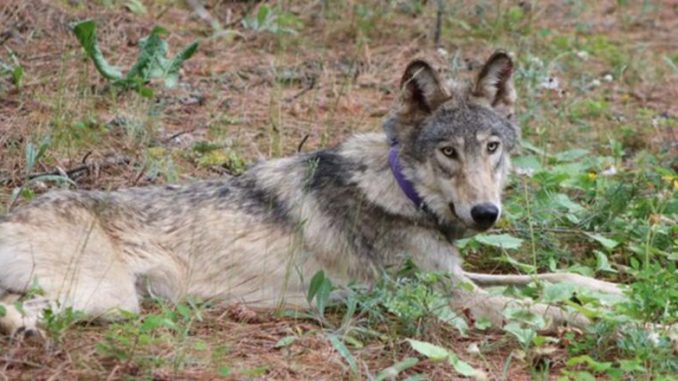
SACRAMENTO, California, November 26, 2021 (ENS) – A wolf that made national headlines by becoming the first reported wolf on California’s central coast in up to 300 years has died after a vehicle struck him near the Interstate 5 highway.
The young radio-collared male wolf from Oregon, named OR-93, first entered California on January 30 and traveled as far south as the southern Sierras and then west to San Luis Obispo and Ventura counties, earning the nickname the Traveling Wolf.
“I’m devastated to learn of the death of this remarkable wolf,” said Amaroq Weiss, senior wolf advocate with the nonprofit Center for Biological Diversity.
“His epic travels across California inspired the world. In this annual time of reflection, I thank him for the hope he gave us and for a brief glimpse into what it would be like for wolves to roam wild and free again. I only wish we’d been able to provide him with a safer world,” Weiss said.
Weiss sees the wolf’s death as a reminder that wildlife habitat, especially in California, has been sliced up by roads and development. In Kern County, where OR-93’s body was found, the wildlands are threatened by sprawl development.
“California has to do so much more to preserve wildlife connectivity and protect animals like OR-93 from car strikes,” he said.
The Center for Biological Diversity points out that, “Protecting habitat and building effective wildlife crossings in the form of overpasses and underpasses would help wolves safely re-establish here and prevent imperiled species like mountain lions from becoming locally extinct.”
The California Department of Fish and Wildlife says OR-93’s death was reported by a truck driver on November 10 to the Oregon Department of Fish and Wildlife after the wolf’s body was seen along a dirt trail on a frontage road on Interstate 5. Examination at the state wildlife forensics lab confirmed that OR-93 died of injuries consistent with a vehicle strike.
OR-93 was just over a year old when he was fitted with a radio collar in June 2020, near where he was born, south of Mt. Hood in Oregon.
He left his pack and headed south, arriving in Modoc County, California in late January. He continued traveling swiftly, moving through more than a dozen counties by late March. He then turned west and continued to San Luis Obispo County, where his last radio-collar signal was detected in early April. In late August a Kern County landowner checked his trail camera and discovered a video of the wolf taken near a water trough on his property in mid-May. In late September, three visual sightings were made of OR-93 in northern Ventura County.
“OR-93’s epic California journey was a beacon of hope in a time when other states are waging a brutal war on wolves, killing them by the hundreds,” Weiss said. “He was simply doing what wolves do, heading out on his own, searching for a mate.”
“I always knew the odds of his finding another wolf on the Central Coast were slim to none, but his relentless wanderings seeking a kindred spirit connected him to the hearts of so many. He won’t be forgotten, and we’ll honor his memory by continuing to fight for the safety of wolves everywhere,” said Weiss.
California’s wolves were wiped out in the early 1900s by a nationwide, government-sponsored eradication program on behalf of the livestock industry.
Wolves began to return to Oregon and Washington in the 2000s. In 2011 a wolf from Oregon, OR-7, made his way into California, becoming the first wild wolf confirmed in the state in 87 years. Since then, more wolves have ventured into the state from Oregon and elsewhere.
Only 20 known wolves now live in California. The state’s wolves include the Lassen pack, whose territory covers portions of Plumas and Lassen counties, the Beckwourth pack in eastern Plumas County and the Whaleback pack in eastern Siskiyou County.
Gray wolves are protected as an endangered species under California state law. Federal protections for wolves were ended by the federal government on October 29, 2020, when the Trump Administration finalized a controversial rule that removed Endangered Species Act protections for all gray wolves in the lower 48 states, except Mexican gray wolves in Arizona and New Mexico, and turned wolf management over to states and tribal governments.
“After more than 45 years as a listed species, the gray wolf has exceeded all conservation goals for recovery,” then Secretary of the Interior David Bernhardt said in a statement at the time. “Today’s announcement simply reflects the determination that this species is neither a threatened nor endangered species based on the specific factors Congress has laid out in the law.”
Republican lawmakers at many governmental levels, most from western states, supported the rule.
But a host of conservation groups criticized the wolf delisting as premature and are challenging the decision in court. In January, Earthjustice filed the lawsuit on behalf of Defenders of Wildlife, Center for Biological Diversity, Sierra Club, National Parks Conservation Association, Oregon Wild, and the Humane Society of the United States.
They argue that the Endangered Species Act requires a species to be recovered through a significant portion of its range before removing federal protections, and that hunting, trapping, poaching, and vehicle collisions pose real threats to wolf recovery where populations are small.
Featured image: Wolf OR-93. (Photo courtesy Austin James, Jr., Confederated Tribes of Warm Springs)



